Toyota Tsusho Bundle
How Does Toyota Tsusho Company Thrive in the Global Market?
Toyota Tsusho Company, a pivotal entity within the Toyota Group, is a global trading powerhouse involved in everything from automobiles to food. With a staggering revenue of approximately $65.8 billion USD in the fiscal year ending March 2025, understanding its operations is vital for anyone interested in the financial markets. This in-depth analysis explores the Toyota Tsusho SWOT Analysis and unravels the complexities of its business model.
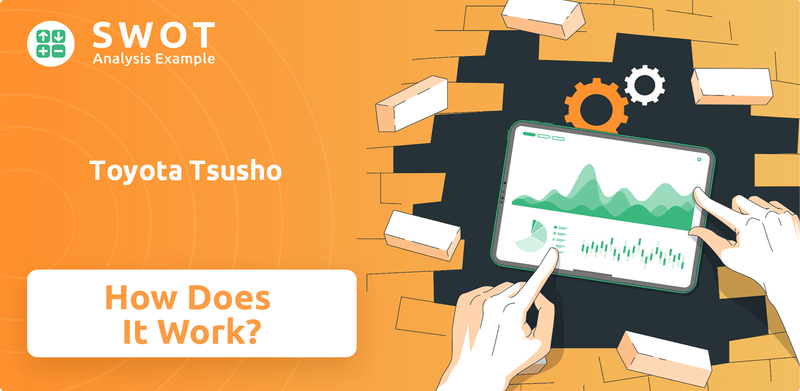
Toyota Tsusho's vast network, encompassing over 150 offices and 900 subsidiaries, facilitates extensive Toyota trading company activities across more than 100 countries. Its success stems from integrated supply chain solutions and strategic investments, making it a key player in the global economy. This examination will provide actionable insights into Toyota Tsusho's financial performance, its commitment to sustainability, and how it generates profit across its diverse business segments, offering a comprehensive view of its operations.
What Are the Key Operations Driving Toyota Tsusho’s Success?
The Toyota Tsusho Company operates as a global trading and investment firm, deeply integrated with the Toyota Group. Its core function involves facilitating trade and investment across diverse sectors worldwide. The company's value proposition lies in its ability to connect businesses and markets, providing comprehensive solutions that span multiple industries.
Toyota Tsusho's business model is built on a diversified portfolio of operations, which include trading, logistics, manufacturing, and investment activities. This multifaceted approach allows it to serve a wide range of customers and adapt to changing market conditions. Its extensive global network and deep industry knowledge are key to its success.
Toyota Tsusho creates value through a highly diversified operational structure, serving a broad spectrum of customer segments globally. Its core operations are categorized into several key business segments: Metals, Global Parts & Logistics, Mobility, Machinery, Energy & Projects, Chemicals & Electronics, Food & Consumer Services, and Africa.
The Mobility division exports vehicles from Toyota Group companies and other manufacturers to 154 countries and regions. It also manages distributor and dealership businesses, vehicle assembly, after-sales service, and spare parts supply. Captive finance and leasing operations are conducted in 48 countries.
The company's logistics operations are extensive, with a fleet of over 2,000 vehicles. It partners with key logistics providers, facilitating the export and import of goods across over 100 countries. The Supply Chain Division offers tailored procurement and supply chain solutions.
This division focuses on providing optimal products and logistics for steel and non-ferrous metals. It manages both types of products across multiple strategic business units.
Procures and distributes a wide range of foods globally, including fish, meat, vegetables, fruits, beans, wines, and seasonings. It also develops higher-added-value products using new technologies and ingredients.
Toyota Tsusho's 'On-Site, Hands-On, In-Touch' approach emphasizes direct engagement with customers and partners. This fosters a deep understanding of their needs, enabling tailored solutions. The company's strong global network and affiliation with the Toyota Group enhance its capabilities.
- Integrated solutions span multiple industries and geographies.
- Enhanced efficiency and reduced costs for customers.
- Reliable sourcing through a vast network of suppliers.
- Manages over 1,000 suppliers globally across sectors like automotive, chemicals, and machinery.
Toyota Tsusho SWOT Analysis
- Complete SWOT Breakdown
- Fully Customizable
- Editable in Excel & Word
- Professional Formatting
- Investor-Ready Format
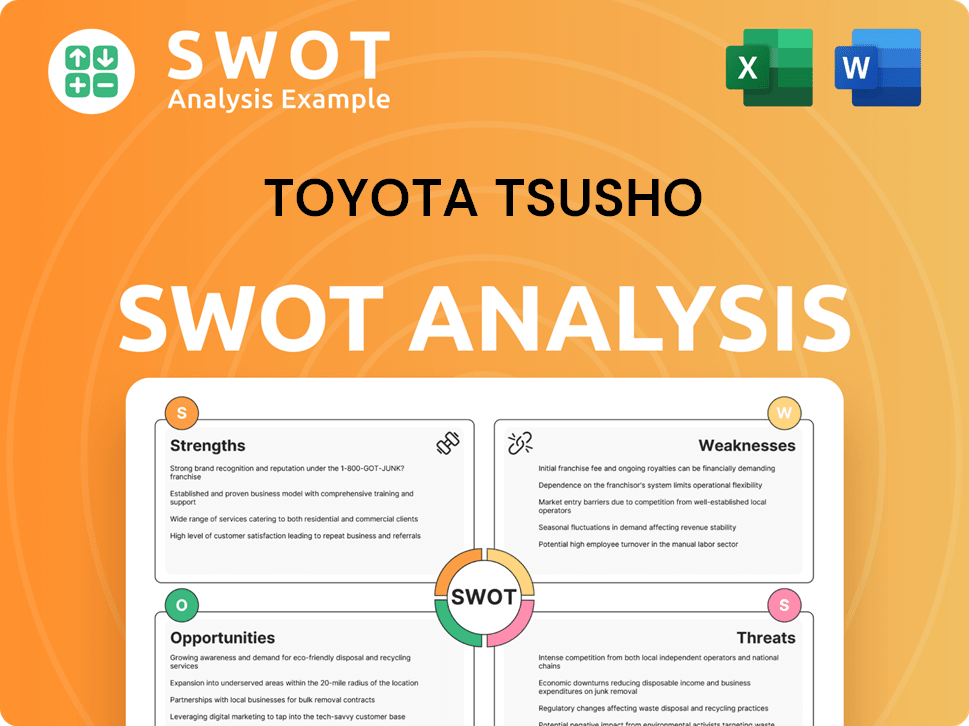
How Does Toyota Tsusho Make Money?
The Toyota Tsusho Company, a core entity within the Toyota Group, generates revenue through a diversified portfolio of business segments. These segments span various sectors, including metals, mobility, and energy, reflecting its broad operational scope. Understanding the Toyota Tsusho business model requires examining its revenue streams and how it monetizes its diverse offerings.
Toyota Tsusho's financial performance showcases its robust revenue generation capabilities. The company's revenue streams are multifaceted, encompassing product sales, services, and strategic investments, which contribute to its overall financial health. The Toyota Tsusho operations are designed to capitalize on global market opportunities and adapt to evolving economic landscapes.
Toyota Tsusho reported consolidated revenue of JPY 10,309.5 billion for the fiscal year ending March 31, 2025, a 1.2% increase from the previous year. This growth demonstrates the company's ability to maintain and expand its revenue base. The consolidated operating profit for the same period increased by 12.6% year-on-year to JPY 497.1 billion, and profit attributable to owners of the parent increased by 9.4% to JPY 362.5 billion. These figures highlight the company's strong financial performance and effective management of its diverse business interests.
Toyota Tsusho employs various monetization strategies that extend beyond simple product sales. These include logistics solutions, after-sales services, and financial services related to vehicle sales. The company's approach also emphasizes expanding its circular economy strategies, which involve recycling materials and contributing to sustainable business practices. For more insights into the company's growth strategies, consider reading about the Growth Strategy of Toyota Tsusho.
- Metals: This segment likely involves trading and processing various metals, essential for manufacturing and infrastructure.
- Global Parts & Logistics: This focuses on the distribution and logistics of parts, supporting the automotive and other industries.
- Mobility: This division operates distributor and dealership businesses and provides financial services related to vehicle sales.
- Machinery: This segment deals with the trading and servicing of industrial machinery and equipment.
- Energy & Projects: This involves investments and operations in the energy sector, including renewable energy projects.
- Chemicals & Electronics: This segment trades in chemicals and electronic components, supporting various manufacturing processes.
- Food & Consumer Services: This focuses on food-related businesses and consumer services.
- Africa: This segment likely encompasses various business activities and investments within the African market.
Toyota Tsusho PESTLE Analysis
- Covers All 6 PESTLE Categories
- No Research Needed – Save Hours of Work
- Built by Experts, Trusted by Consultants
- Instant Download, Ready to Use
- 100% Editable, Fully Customizable
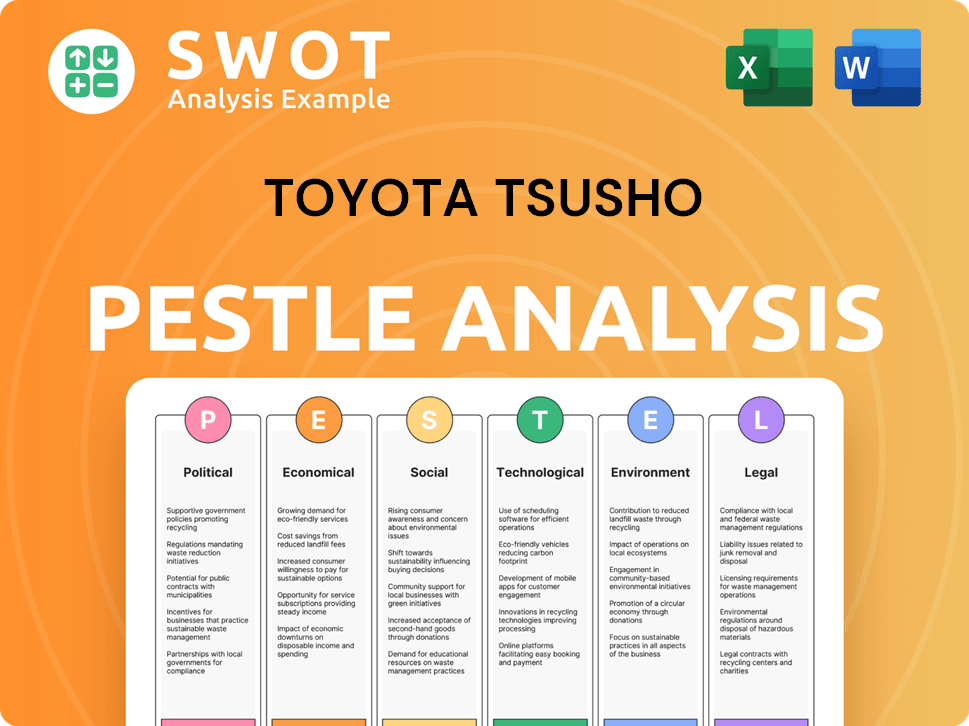
Which Strategic Decisions Have Shaped Toyota Tsusho’s Business Model?
The Toyota Tsusho Company has a rich history marked by significant milestones and strategic decisions that have shaped its operations and financial performance. These moves have positioned the company as a key player in global trade and a leader in sustainable business practices. The company's ability to adapt and innovate has been crucial in navigating the complexities of international markets and maintaining a competitive edge.
A series of strategic acquisitions and investments have been central to Toyota Tsusho's growth strategy. These moves have expanded its business scope and strengthened its market position. The company's focus on sustainability and digital transformation also highlights its commitment to long-term value creation and adapting to evolving market trends. Understanding these key aspects is essential for anyone interested in the Toyota Tsusho business model and its future prospects.
The company's operations are influenced by various market dynamics and global economic conditions. Currency fluctuations and geopolitical tensions are among the challenges that Toyota Tsusho navigates. Despite these hurdles, the company has consistently pursued growth, aiming to maintain its strong financial performance and expand its global footprint. For a deeper dive into the company's target audience, consider reading about the Target Market of Toyota Tsusho.
A major milestone in March 2025 was the acquisition of Radius Recycling for approximately $907 million, expected to finalize in Q3 2025. This move is part of Toyota Tsusho's sustainability strategy. Another key move in January 2025 was the acquisition of Elematec Corporation, focusing on electronic materials.
The acquisitions of Radius Recycling and Elematec Corporation are strategic moves to expand its circular economy initiatives and enhance corporate value. These moves reflect a proactive approach to growth and market diversification. The company is also investing in EV technology and hydrogen fuel cells.
The strong affiliation with the Toyota Group provides a globally recognized brand reputation, valued at approximately $58.4 billion USD in 2023. Its extensive global network and commitment to sustainability are key competitive advantages. The company also focuses on deep customer engagement through its 'On-Site, Hands-On, In-Touch' philosophy.
The company anticipates a profit forecast of JPY 350.0 billion for FY2025, a slight improvement from the expected JPY 340 billion in FY2024. Toyota Tsusho allocated approximately JPY 32 billion to R&D in 2023. The company is actively pursuing digital transformation.
Toyota Tsusho's competitive advantages stem from its strong brand reputation, extensive global network, and commitment to sustainability. The company's focus on customer engagement and technological innovation further strengthens its market position. These factors contribute to the company's ability to navigate market challenges and capitalize on growth opportunities.
- Strong affiliation with the Toyota Group, enhancing trust and opening business opportunities.
- Extensive global network with over 900 subsidiaries and operations in over 100 countries.
- Commitment to sustainability, targeting carbon neutrality by 2050.
- 'On-Site, Hands-On, In-Touch' philosophy for deep customer engagement and tailored solutions.
Toyota Tsusho Business Model Canvas
- Complete 9-Block Business Model Canvas
- Effortlessly Communicate Your Business Strategy
- Investor-Ready BMC Format
- 100% Editable and Customizable
- Clear and Structured Layout
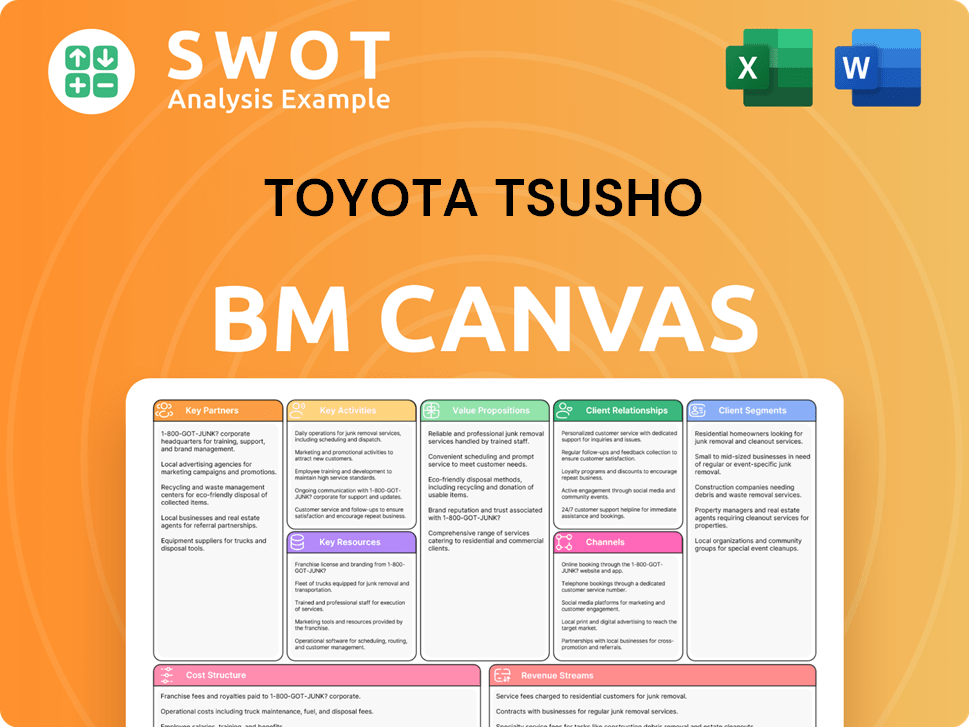
How Is Toyota Tsusho Positioning Itself for Continued Success?
As a global trading company and a key member of the Toyota Group, Toyota Tsusho Company holds a significant market position. Its diversified portfolio spans automotive, metals, machinery, energy, chemicals & electronics, food & consumer services, and logistics. With over 150 offices and 900 subsidiaries and affiliates globally, Toyota Tsusho demonstrates a substantial reach. Moreover, its dividend yield of 3.89%, surpassing the Japanese trade distributor industry average, and a projected rise to 4.3% by 2025, highlights strong financial health and investor confidence.
However, Toyota Tsusho business faces several risks. These include geopolitical instability, particularly in African markets, which can disrupt supply chains. Currency fluctuations, such as a strong yen, can negatively impact overseas operations. The company is also exposed to commodity price volatility. Additionally, as a major trading entity, it encounters risks related to business investments, customer concentration, with sales to the Toyota Group accounting for 17.4% of revenue, and natural disasters. To learn more about the company's origins, you can explore the Brief History of Toyota Tsusho.
Toyota Tsusho operates as a major global trading company, benefiting from its association with the Toyota Group. Its extensive global network and diversified business segments provide a solid foundation. The company's dividend yield and projected growth show a strong financial standing within its industry.
Toyota Tsusho is exposed to geopolitical risks, currency fluctuations, and commodity price volatility. Risks are also associated with its investments and customer concentration. The company's operations are also vulnerable to natural disasters.
Toyota Tsusho aims for a JPY 350.0 billion profit in FY2025, indicating confidence in future stability. Strategic initiatives include the integration of Terras Energy Corporation and Eurus Energy Holdings Corporation to create a leading wind and solar power company. The company is also investing in hydrogen infrastructure and exploring new mobility solutions.
Toyota Tsusho is focused on sustainable growth through several strategic moves. These include investments in renewable energy, such as wind and solar power. The acquisition of Radius Recycling enhances its circular economy practices. Digital transformation is also a key area of focus to improve efficiency and create new value.
Toyota Tsusho is actively pursuing strategies to ensure long-term profitability and sustainability. This involves expanding its renewable energy initiatives and investing in new technologies. The company is committed to achieving carbon neutrality by 2050.
- Integration of Terras Energy Corporation and Eurus Energy Holdings Corporation.
- Investment in hydrogen supply infrastructure.
- Acquisition of Radius Recycling to enhance circular economy practices.
- Focus on digital transformation for improved efficiency.
Toyota Tsusho Porter's Five Forces Analysis
- Covers All 5 Competitive Forces in Detail
- Structured for Consultants, Students, and Founders
- 100% Editable in Microsoft Word & Excel
- Instant Digital Download – Use Immediately
- Compatible with Mac & PC – Fully Unlocked
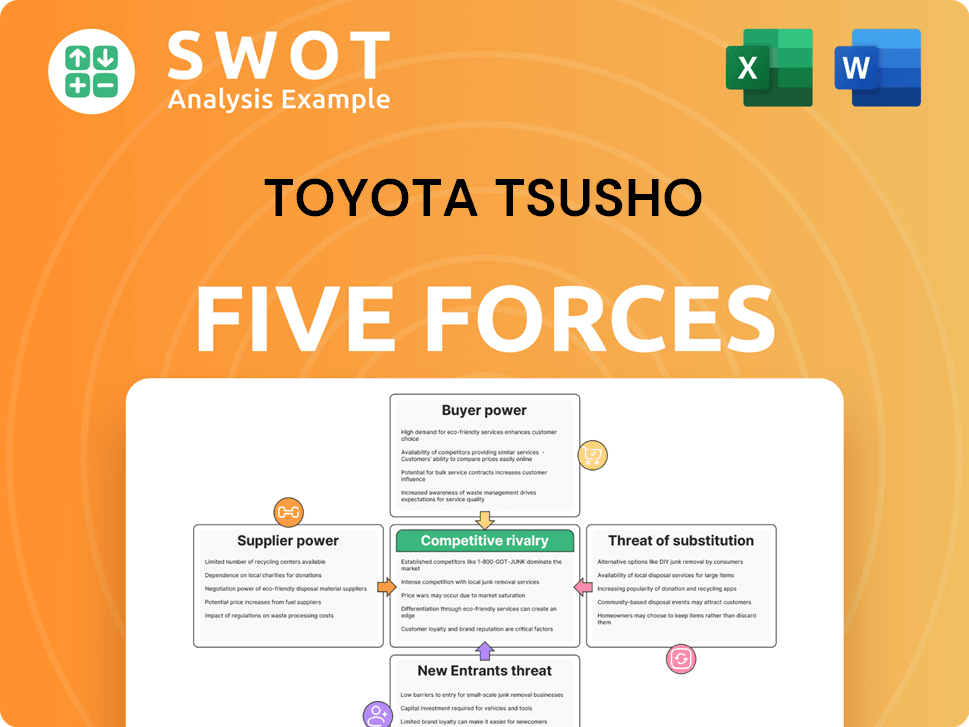
Related Blogs
- What are Mission Vision & Core Values of Toyota Tsusho Company?
- What is Competitive Landscape of Toyota Tsusho Company?
- What is Growth Strategy and Future Prospects of Toyota Tsusho Company?
- What is Sales and Marketing Strategy of Toyota Tsusho Company?
- What is Brief History of Toyota Tsusho Company?
- Who Owns Toyota Tsusho Company?
- What is Customer Demographics and Target Market of Toyota Tsusho Company?
Disclaimer
All information, articles, and product details provided on this website are for general informational and educational purposes only. We do not claim any ownership over, nor do we intend to infringe upon, any trademarks, copyrights, logos, brand names, or other intellectual property mentioned or depicted on this site. Such intellectual property remains the property of its respective owners, and any references here are made solely for identification or informational purposes, without implying any affiliation, endorsement, or partnership.
We make no representations or warranties, express or implied, regarding the accuracy, completeness, or suitability of any content or products presented. Nothing on this website should be construed as legal, tax, investment, financial, medical, or other professional advice. In addition, no part of this site—including articles or product references—constitutes a solicitation, recommendation, endorsement, advertisement, or offer to buy or sell any securities, franchises, or other financial instruments, particularly in jurisdictions where such activity would be unlawful.
All content is of a general nature and may not address the specific circumstances of any individual or entity. It is not a substitute for professional advice or services. Any actions you take based on the information provided here are strictly at your own risk. You accept full responsibility for any decisions or outcomes arising from your use of this website and agree to release us from any liability in connection with your use of, or reliance upon, the content or products found herein.